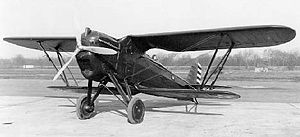Berliner-Joyce P-16 Video - Picture
More Berliner-Joyce P-16 Videos 1

|
|

Picture: Berliner-Joyce P-16
Role - Two-seat fighter
Manufacturer - Berliner-Joyce Aircraft Corporation
First flight - 1 September 1930
Introduced - 1932
Retired - 1940
Primary user - United States Army Air Corps
Number built - 26
The Berliner-Joyce P-16 was a 1920s United States two-seat fighter aircraft produced by Berliner-Joyce Aircraft Corporation.
Design and development
 Picture: Berliner-Joyce
P-16 c. 1933
Picture: Berliner-Joyce
P-16 c. 1933
The Berliner-Joyce Aircraft Corporation was established in February 1929 when it acquired the assets of the Berliner Aircraft Company. The new company had intended to develop the Berliner Monoplane but became involved in designing a two-seat fighter for the United States Army Air Corps. The prototype (designated the Berliner-Joyce P-16) first flew in October 1929. It had a metal structure with a fabric covering. It was a single-bay biplane of unequal span, with the wings forward-staggered. The lower wing was smaller than the upper and was mounted at the base of the fuselage. The upper wing was of gull wing configuration. An observer/gunner was located behind the pilot. The aircraft was powered by a 600 hp (447 kW) Curtiss V-1570 Conqueror supercharged inline engine. After evaluation by the USAAC two contracts were awarded for a total of 25 aircraft as YP-16s (the first 15 were considered preproduction). The main difference with the production aircraft was the use of an unsupercharged version of the Conqueror engine, and a three-bladed propeller.
Operational history
During 1931, the USAAC ordered the aircraft and the US Navy ordered a carrier-based version, the F2J-1. The Berliner-Joyce YP-16 had the distinction of being the last biplane fighter to enter service with the USAAC. In addition, the P-16 remained the only two-seat biplane fighter to be produced for the army after 1918.
Delivered in 1932 as the Y1P-16 primarily equipping the 94th Pursuit Squadron, the production aircraft were later re-designated PB-1 (pursuit-biplace, an awkward name for the class of aircraft and only applied to one other type)[1]. Without the prototype's supercharger, performance at altitude was appreciably reduced although the aircraft had a greater endurance than contemporary single-seat pursuits.[1] Despite the gull-wing, pilots had poor visibility over the nose which contributed to service pilots having a propensity to nose-over on landing.
All Berliner-Joyce PB-1s were withdrawn from active service in 1934, although a small number of aircraft continued in second line duties until 1940.
Berliner-Joyce P-16 c. 1933
The F2J-1 suffered from the same faults as the P-16, resulting in an unfavourable service trial of the one prototype, which had appeared two years late due to a protracted development phase, eacerbated by financial difficulties that eventually led to the demise of the company [2]
Variants
P-16
Prototype with 600hp V-1570-25 engine, one built.
Y1P-16
Production version, became P-16 after evaluation, 25 built.
P-16
In-service designation of the 25 production aircraft, re-designated PB-1 in 1935.
PB-1
Production aircraft re-designated from P-16 in 1935.
Operators
United States
- United States Army Air Corps
Specifications (P-16)
General characteristics
- Crew: 2
- Length: 28 ft 2 in (8.59 m)
- Wingspan: 34 ft 0 in (10.36 m)
- Height: 10 ft 2 in (3.10 m)
- Wing area: 290.64 ft² (27 m²)
- Empty weight: 2,734 lb (1240 kg)
- Ma takeoff weight: 3,968 lb (1800 kg)
- Powerplant: 1× Curtiss V-1570-25 Conqueror inline piston, 600 hp (447 kw)
Performance
- Maimum speed: 172 mph (282 km/h)
- Range: 650 miles (1046 km)
Armament
two fied forward firing and one fleible mounted 0.3in (7.62mm) machine guns, maimum bombload of 224lb (102 kg)
References
1. a b Wagner 1968, p. 184-185.
2. Baugher, Joe. Berliner-Joyce P-16/PB-1. Berliner-Joyce P-16/PB-1 Access date: 22 June 2007. Note: The poor visibility over the nose and the landing
characteristics doomed the F2J-1, especially in light of the availability of the superior Grumman FF-1.
- Dorr, Robert F. and Donald, David. Fighters of the United State Air Force: From World War I Pursuits to the F-117. New York: Military Press, 1990.
ISBN 0-51766-994-3.
- The Illustrated Encyclopedia of Aircraft (Part Work 1982-1985). London: Orbis Publishing.
- Wagner, Ray. American Combat Planes. New York: Doubleday and Company, 1968. ISBN 0-385-04134-9.
Living Warbirds: The best warbirds DVD series.
Source: WikiPedia